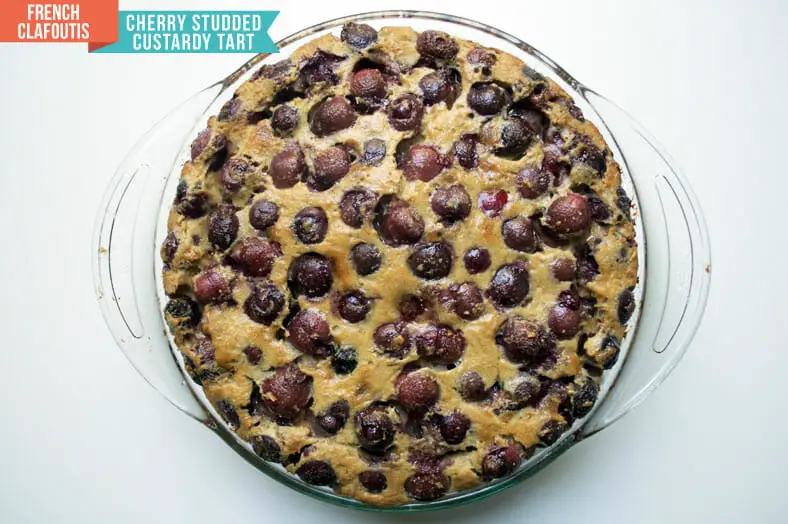This recipe is a made-from-scratch mini tarts using real fresh cherries. It uses easy to find ingredients such as flour, butter, whole milk, and fresh cherries. Whenever we find a recipe that combines fruit and pastry we get really excited, like this other recipe we found from the Samoans – a pineapple empanada (paifala), that you ought to check out.
When you think French cooking, more often than not what comes to mind are the more prim, proper and posh aspects of the cuisine. Clafoutis is a French Cherry Tart that’s delicious and easy to make.
This is, for the most part, to be largely expected. Thanks to the impact from the likes of Careme, Escoffier, Bocuse and oh so many more, most of us would immediately associate the haute cuisine directly to the French culinary tradition.
But this is only part of the greater picture and overlooks, you could say, a more rustic “underbelly” to French cooking… despite the increasing popularity of dishes like clafoutis and cassoulet.
Regardless of the acclaim (or lack thereof), there is beautiful food coming from the different, independent and unique regions of what was once the Occitan.

Occitania, Limousin and the Power of Nature
You could say there’s a “hidden country” tucked between the borders of the modern day nations in Southern Europe. While not a formalized country on its own anymore, this massive region shares a deeply entrenched common identity – one dating back to the times of the Roman Empire – that transcends current geopolitics with something far more meaningful.
That land is Pais d’Oc, otherwise known as the Occitania.
Gallia Aquitania and Unified Lands
As far as historically and culturally significant regions go, Occitania is certainly one of the more tricky ones, and part of the reason underlying is because of how un-codified it has been throughout history.
Technically, the land of Occitania has rarely been a formally recognized unified territory. In the days of the Roman Empire, the lands of Occitania – which stretch from the Aran valley in Catalonia through the southern half of France and into the Guardia Piedmontese of northern Italy – were unified as Gallia Aquitania and recognized as one of the Septem Provinciæ, or seven provincial jurisdictions for the entire Roman Empire.
Under the later Visigoth, Merovingian and Carolingian kingdoms after the Roman Empire’s collapse, the lands of the old Gallia Aquitania remained relatively intact leading into the Early Middle Ages. Following a division of the Frankish Empire in the 9th century, however, the lands haven’t been politically united again.
Occitan Culture and Repression
Despite this continuing longstanding geopolitical fracturing, these lands have retained a deeper common culture that has bound its people together, albeit psychologically. This common culture, first referred to as Occitanian from the 10th century onwards, has offered significant cultural contributions in the areas of literature, food, music, art and more over the last millennium. By its peak in the 12th and 13th centuries, the lenga d’oc (Occitan language) was a lingua franca in the aristocratic and sophisticated circles throughout all of Europe.
As French kings systematically conquered the Occitan lands between the 13th and 17th centuries, the Occitan people endured prolonged periods of cultural repression and, in some extreme cases, mass slaughterings on account of their cultural ties. The French motivation here was to extinguish the Occitan culture in favor of a larger pan-French assimilated way of life.
And yet, even with all the repression and stigma associated with all things Occitan, the lenga d’oc and overall Occitan culture has persevered and remains prevalent even to this day. In some ways, the Occitan culture is beginning to even thrive again, as evidenced by contemporary Occitan music and strongly represented communities in France, online and throughout other parts of the world.
Limousin and its Occitan-Styled Cuisine
Considering Occitania hasn’t been a unified political nation for the last 12+ centuries, it’s hard to define what you can call a “pan-Occitanian” culture. Rather, what has emerged is a subset of smaller, local cultures that all share the common bond of the lenga d’oc.
Clafoutis in particular brings us to the region of Limousin in south-central France. While a broader “Occitanian cuisine” – if it were to exist – carries a lot of similar characteristics to other Mediterranean cuisines, the Limousine cuisine itself boasts special intricacies that separate it from the rest both of other French and Occitanian cuisines.
In Limousin, we don’t have caviar, but we do have walnuts
– Antoine Blondin (translated), 20th century writer
Before diving deeper into Limousine cuisine, it’s important to point out that, while it is now earning the recognition and praise it deserves, it was not always this way. In fact, at the apex of the rise of the haute cuisine, the simple and economical tenets of the Limousine cuisine were generally looked down upon by the Parisian elite.
The Limousine endured harsh names like “chestnut eaters” and denigrating comments of a “boorish” cuisine very early on. And yet, with the rising popularity of dishes like clafoutis, it is now begining to receive its proper due.
At the heart of the Limousine cuisine are the core practices of simplicity, non-wastefulness and use of the gifts from the local natural lands. Granted, it doesn’t hurt that the geography and climate of Limousin yields fantastic natural food products from the forests, the farms, the rivers and everything in between.
In particular, Limousin is renowned for three things: its cognac, its cattle, and its cherries. Because of a special distinctive oak grown only in the region, cognac aged in barrels made from this special oak is famous for its highly distinctive flavor. As for the cattle, the region’s landscapes offer an environment in which the cattle develop luscious red, super lean meat that has become highly a sought after delicacy in the rest of France.
And then there’s the famous black cherries, which have become popularized thanks to the clafoutis.

About the Recipe
First, a quick word about the difference between a clafoutis and a flaugnarde.
The clafoutis, in the most traditional sense, features one of the prized fruits grown in the Limousin region: the black cherry. With the increased popularity of the recipe, however, chefs from outside Limousin have started creating their own variations of this traditional cake dessert. Suddenly, other fruits like pears, apples, plums, blackberries and more made their way as the feature fruit into these desserts.
While these desserts can be just as delicious as the clafoutis, they just aren’t quite the original thing. As a result, there’s a different name for these “other” dishes: the flaugnarde.
The honor for the true clafoutis, on the other hand, remains reserved for the cherry.
Anyways, the name clafoutis explains perfectly what exactly happens in this recipe. Derived from the Occitan word clafir, or “to fill” in English, the goal of this incredibly simple cake-like dessert is to create a batter filling around the feature ingredient: the cherry.
Clafoutis and Cherries
First, there are the cherries. A key natural product yielded from the Limousine terrain, the black cherry in some ways serves as a point of pride for the locals. Limousine cherries in particular offer a slightly more tart taste than other cherries to your clafoutis, although any local batch of cherries will do perfectly fine.
In the most traditional of clafoutis recipes, you’re suggested to leave the pits of the cherries intact for this cake dessert. The reasoning here is that cherry pits generally contain amygdalin, also known as the active chemical ingredient found in almond extract. If you were to leave the pits in, the heat from baking the clafoutis would help release the amygdalin into the rest of the dessert. What results is a slightly nutty complementary flavor to the main light cherry taste.
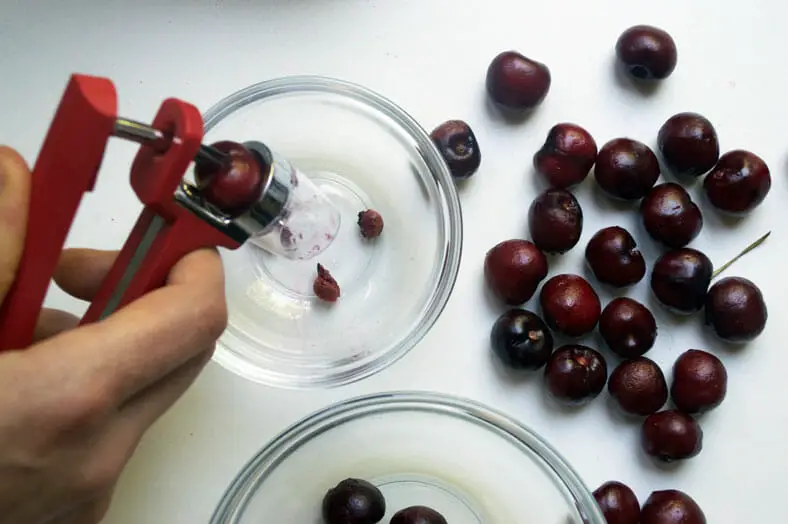
Of course, leaving the pits in does add a slight bit of inconvenience into the eating experience of the clafoutis, so it’s up to you whether or not you decide to leave them in (we didn’t… more on this later).
The Batter
The second key element of the clafoutis is the batter… and a very runny one at that.
Made nearly in the same fashion as crepe batter – although the flour and dry ingredients mix first here – the intention of this batter is to be runny enough to move through and between cherries already placed onto your baking dish.
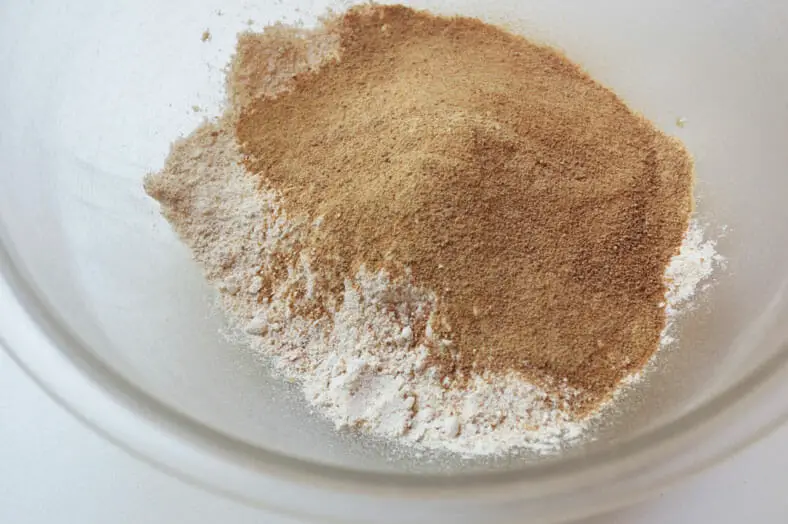
The key to making a really runny batter is to thus involve a lot of wet ingredients, namely milk and eggs. For a more decadent clafoutis, you can add some melted butter as well, which we would certainly recommend.
Making the clafoutis batter starts by mixing together your dry ingredients into a bowl. Next, you start by adding your vanilla extract and milk and then mix everything into a fairly liquid consistency already.
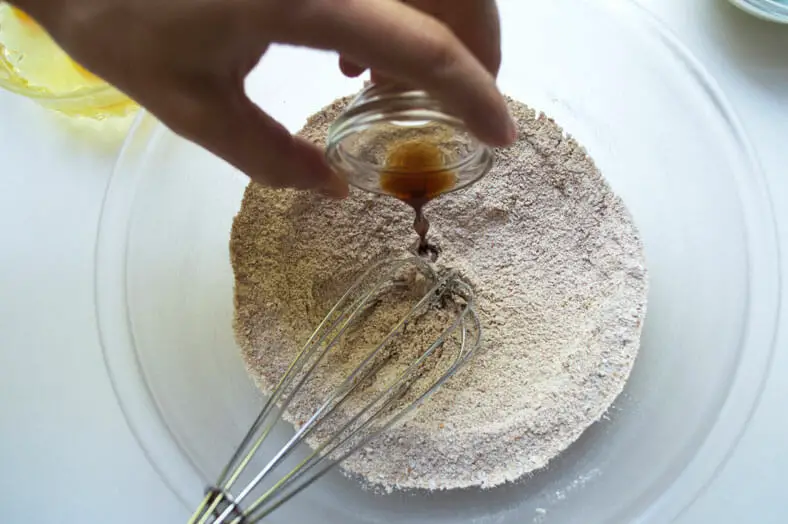
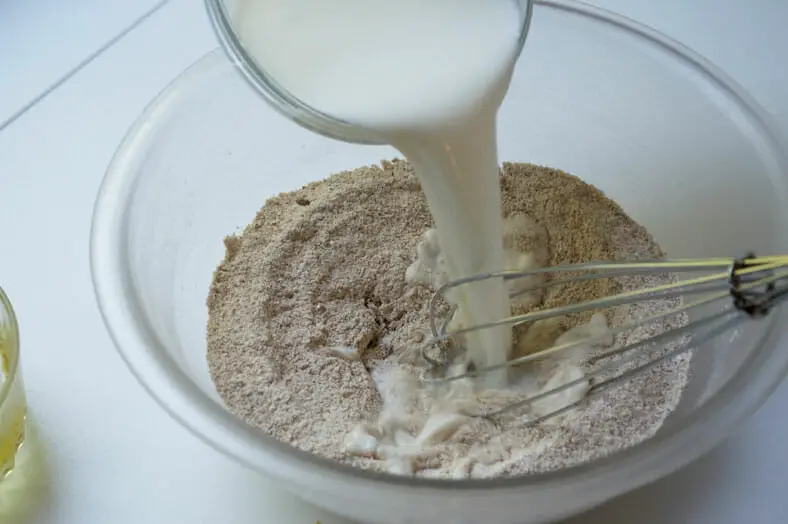
This liquidity is accentuated as you add in your eggs, which are added and mixed into your batter one by one. After all the eggs are added, you then add in any final added ingredients like rose water or your butter.

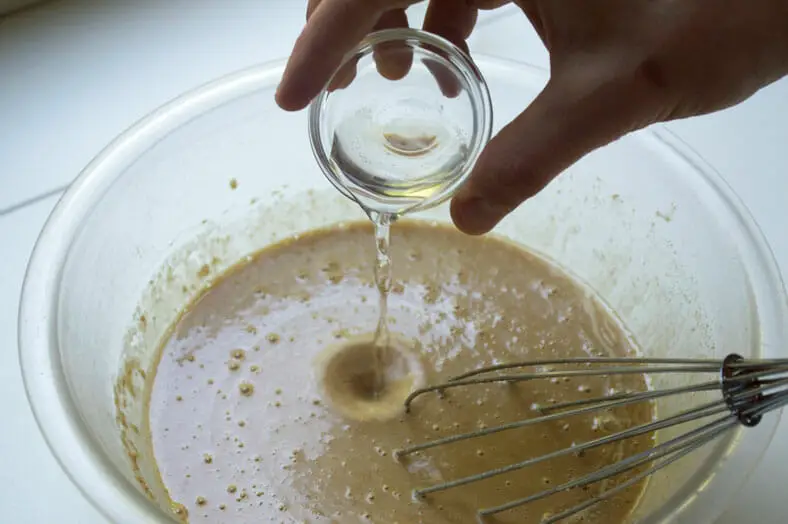
With your extremely runny batter in tow, you start by laying all your cherries out onto your baking dish. Once you have neatly arranged them to fill up the entire dish, pour your batter through and around all the cherries. Making good on its name, the batter will fill the rest of the baking dish, and your clafoutis will be ready to bake in no time.

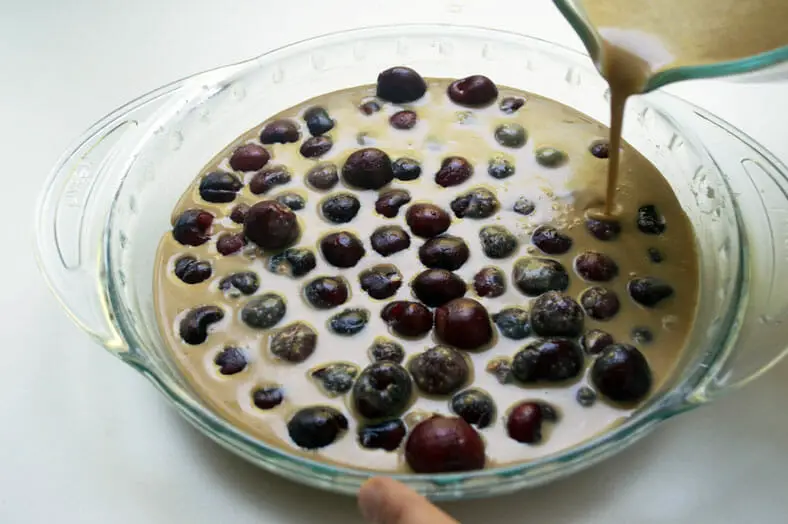
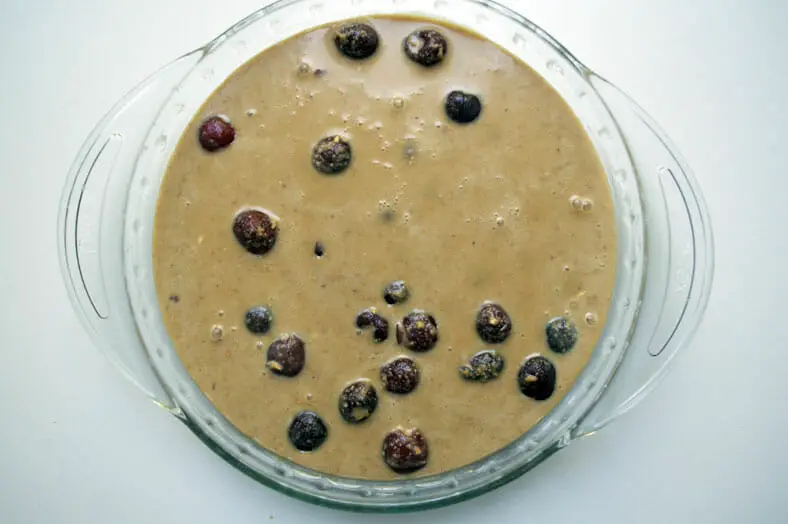
There’s a tad bit of debate on this, but generally you’ll want to serve your clafoutis at room temperature – or a slightly above lukewarm – with a light dusting of powdered sugar on top.
Our Take on the Recipe
Despite the changes that you’ll see we made to our version of clafoutis, we started with the intention of staying as true and authentic to the recipe as we could. For that reason, we chose a recipe from a favorite French blogger of ours, Mimi Thorisson, for our original reference recipe.
One thing we particularly liked about her approach to the clafoutis was the change in heat midway through the baking of the dish. The first 15 minutes are intended to set the clafoutis, whereas the following 30 minutes at a lower heat are to cook it through without leaving it too dry. When trying this approach against others during our tests, this method proved the best in keeping the clafoutis soft, moist and delicious.
As for our version of the recipe, we did take the liberty of making a few adjustments. First, we deliberately used a lower-protein organic pastry flour to create a more flakier, lighter cake around the cherries. From there, we swapped regular sugar for coconut sugar (as always), and we adjusted the vanilla sugar and orange blossom water for vanilla extract and rosewater, respectively.
For the rosewater, we actually put this as an optional ingredients since its not technically considered as part of the most traditional of recipes, but it does add a fantastic and delicate touch to the flavor of the cake.
Finally, with perhaps the greatest deviation of them all, we added melted butter into the batter mixture. We’d seen this added in more than several other recipes, and it really did have an added effect on the decadence and “full” flavor of the clafoutis in general. You don’t have to have it, but we would highly, highly recommend it. The difference (to us at least) was that stark.
All in all, though, the clafoutis is an incredibly simple, super light and delicious cake dessert that everyone should try.

For a dish that comes from the French countryside, it might not have the pomp and circumstance that surrounds delicate Parisian pastries, but it serves as a powerful reminder of what other remarkable cooking is done in other parts of the French (and Occitan) cuisines.
Bon appetit!
Have you tried clafoutis before? What did you think? Comment below!


